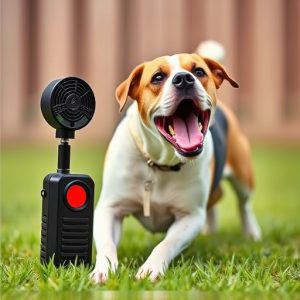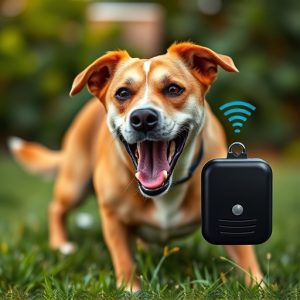Sonic Animal Control: Dog Repellents, Safety, and EMC Certification
Animal control sonic repel systems, featuring crucial Dog Repellent EMC Certification Requirements,…….
Animal control sonic repel systems, featuring crucial Dog Repellent EMC Certification Requirements, have advanced significantly. This certification ensures safety and prevents electromagnetic interference, guaranteeing both animal and human well-being. These eco-friendly and humane systems effectively manage wildlife encounters while adhering to strict EMC standards. By meeting these requirements, dog repellents enhance effectiveness and safety, targeting specific species without impacting nearby wildlife or humans, making them ideal for urban environments.
Animal control has evolved with innovative solutions like sonic repellent systems, offering a non-lethal approach to managing wildlife interactions. This article delves into the world of animal control technology, focusing on sonic repellents and their effectiveness in deterring unwanted visitors. We explore key aspects such as understanding the science behind sound waves, the significance of EMC certification for safety and efficiency, and the specific requirements for dog repellent systems. Get ready to discover how these advanced technologies are transforming animal management.
- Understanding Animal Control Sonic Repellents
- The Role of EMC Certification in Safety and Efficacy
- Dog Repellent Systems: A Comprehensive Look at Requirements
- Implementation and Benefits of Sonic Repellent Systems
Understanding Animal Control Sonic Repellents
Animal control sonic repel systems have gained popularity as a non-lethal method to deter unwanted animals from specific areas. These devices emit high-frequency sound waves that are inaudible to humans but can effectively drive away dogs, cats, and other wildlife. The technology behind these systems has evolved significantly, with many advanced models now available on the market. One crucial aspect to consider is the Dog Repellent EMC Certification Requirements, which ensure that the devices meet strict safety standards for electromagnetic compatibility.
EMC certification guarantees that the sonic repellent systems do not interfere with other electronic devices and are safe for both animals and humans. The certification process involves rigorous testing to confirm that the sound waves produced fall within acceptable frequency ranges and intensities, ensuring minimal impact on nearby environments and people. This is particularly important in residential areas where pets and wild animals coexist. By adhering to these requirements, animal control sonic repel systems offer an eco-friendly and humane solution for managing unwanted wildlife encounters.
The Role of EMC Certification in Safety and Efficacy
The effectiveness and safety of any animal control system, particularly those using sound technology like sonic repellents, are significantly influenced by EMC (Electro-Magnetic Compatibility) certification. This certification ensures that the device operates within safe electromagnetic emission limits, minimizing potential risks to users and the environment. In the context of dog repellents, EMC certification is crucial as it guarantees that the device’s electromagnetic signals do not interfere with other electronic equipment or cause harm to animals through inappropriate frequency ranges.
Meeting specific EMC certification requirements ensures the product’s reliability and performance. For dog repellents, this means confirming compliance with standards that consider both the device’s ability to emit effective sonic waves for deterrence and its safety in operation around potential sensitive environments and living spaces. By adhering to these regulations, manufacturers can offer a safe and efficient solution for keeping dogs away from undesirable areas, enhancing the overall effectiveness of the animal control system.
Dog Repellent Systems: A Comprehensive Look at Requirements
Dog repellent systems, designed to keep canines away from specific areas, are subject to stringent EMC certification requirements. Electromagnetic Compatibility (EMC) ensures that these devices do not interfere with other electronic equipment and vice versa. This is crucial as stray dogs or pets can easily disturb neighborhoods or agricultural lands, creating a need for effective yet safe repellents.
When evaluating dog repellent systems, several key factors come into play. These include frequency range, power output, and the specific type of signal used to deter dogs. Repellents often operate on radio frequencies or ultrasonic waves, both requiring EMC testing to guarantee their performance does not negatively impact nearby devices like radios, phones, or other sensitive electronics. Adhering to EMC certification guidelines ensures the reliability and longevity of these systems in various environments.
Implementation and Benefits of Sonic Repellent Systems
The implementation of Sonic Repellent Systems (SRS) is a non-lethal and eco-friendly approach to managing animal populations, particularly in urban areas. These systems utilize high-frequency sound waves, typically above the human hearing range, to create an unpleasant auditory experience for targeted animals like dogs or rodents. SRS are designed with specific frequency ranges that disrupt the animal’s sense of balance and orientation, encouraging them to leave the treated area.
One of the key benefits of SRS is their selectivity. With EMC (Electromagnetic Compatibility) Certification Requirements met, these systems can target specific species without affecting nearby wildlife or humans. This makes them ideal for urban environments where co-existence with animals is essential. Additionally, SRS offer a humane alternative to traditional repellents, avoiding the use of chemicals or traps that may cause harm. They are also adaptable and can be easily installed and controlled, making them a practical solution for long-term animal control and management.
Animal control sonic repellent systems offer a safe, effective, and non-lethal solution for managing unwanted wildlife. By understanding the principles behind these devices and adhering to stringent requirements like EMC certification, we can ensure their efficacy and safety. For dog repellents, meeting specific EMC certification standards is crucial to guarantee performance without causing harm to pets or humans. Implement these systems wisely, and enjoy the benefits of a harmonious coexistence with both wildlife and domestic animals.


